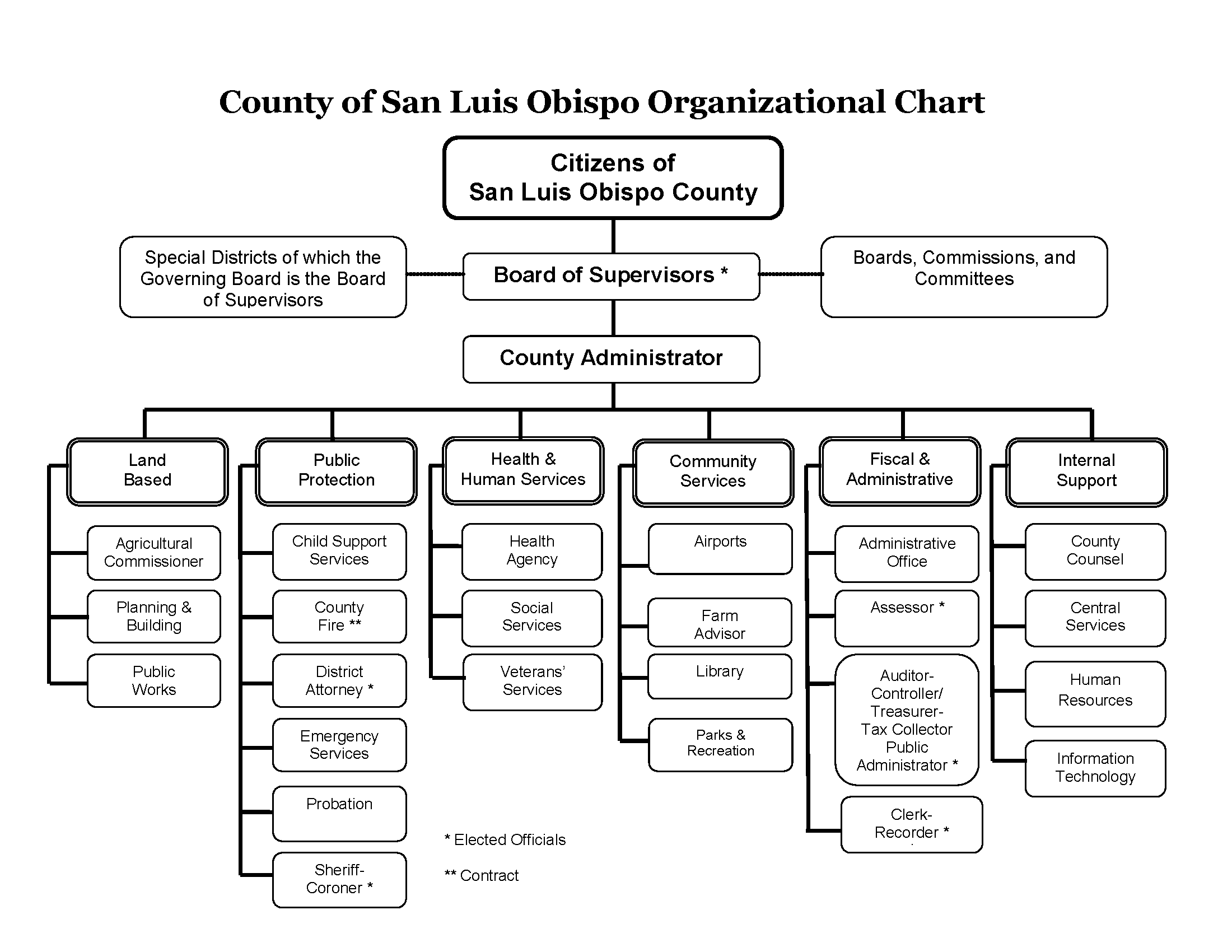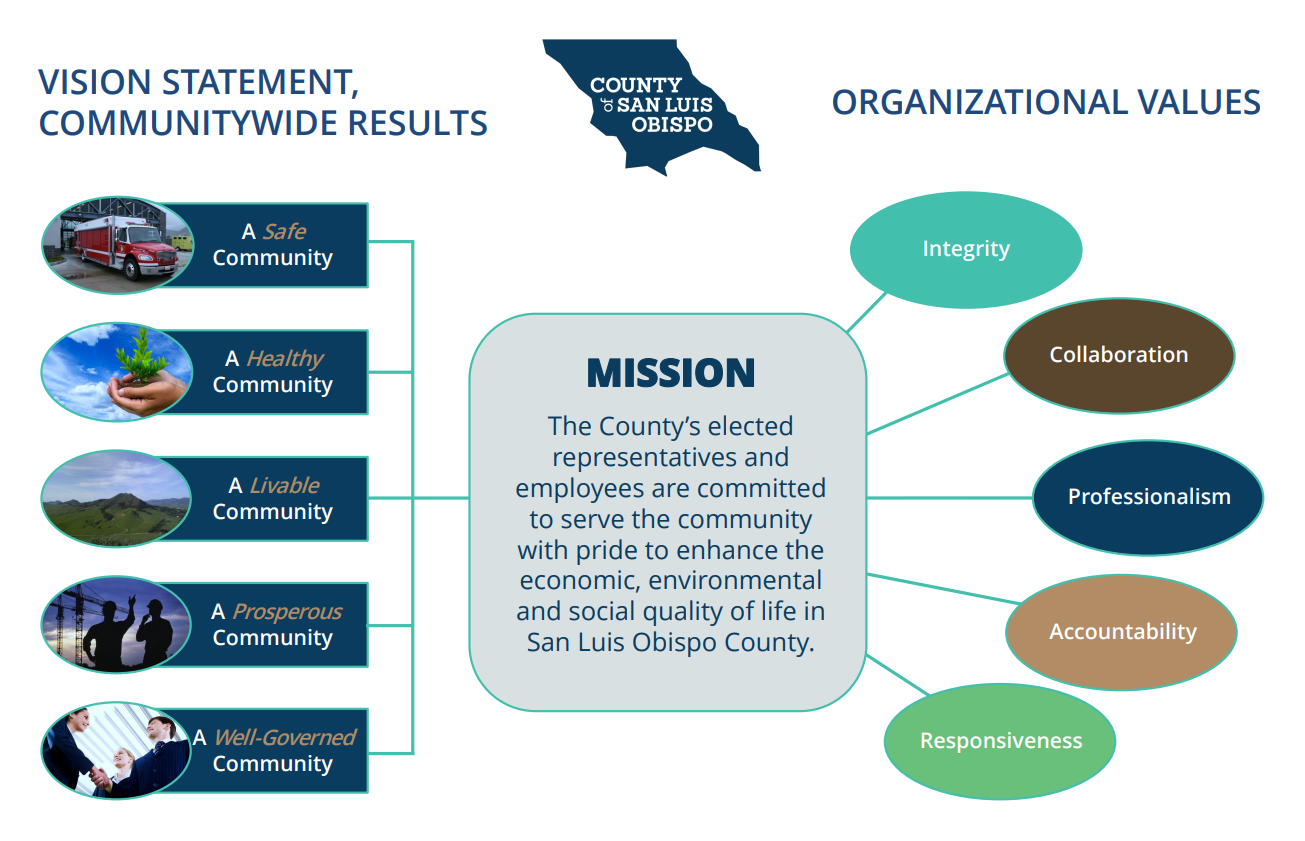About the County
Quick Links
This page contains a wide variety of information. Use these links to jump to the section you're interested in.
The following is an excerpt from "Know Your County: A Guide to Government in San Luis Obispo County", which is compiled and published by the League of Women Voters in San Luis Obispo County, CA.
SLO County at a Glance
The San Luis Obispo County geographic region (SLO County) is located on the Pacific coast, approximately halfway between the metropolitan areas of Los Angeles and San Francisco. SLO County covers approximately 3,300 square miles and is bordered by Monterey County to the north, Kern County to the east, Santa Barbara County to the south, and 100 miles of Pacific coastline to the west.
Estimates from the California Department of Finance in 2016 place San Luis Obispo County’s population at 277,977, making it the 23rd largest county in the State. The county is made up of seven cities as well as many unincorporated communities. The county seat is the City of San Luis Obispo.
Because of its distance from major metropolitan areas, SLO County has been able to retain its small-town and rural character. Despite this, the area also offers many of the same amenities that are found in more populated areas.
SLO County is home to major educational institutions including California Polytechnic State University and Cuesta Community College—both of which draw students from all over the world and provide a wide array of educational and cultural opportunities. The varied geography and rich history of the area provide numerous opportunities for recreation.
The nationally known Hearst Castle in San Simeon attracts over one million visitors each year and the historic Mission San Luis Obispo Tolosa, founded in 1772, is another popular attraction. Many locally sponsored events including the Festival Mozaic, Old-Fashioned Fourth of July, Renaissance Faire, Mid-State Fair, San Luis Obispo Expo, Central Coast Wine Festival, San Luis Obispo County Symphony, Colony Days, Pioneer Days, Strawberry Festival, Central Coast Wine Classic, Clam Festival, Harbor Festival, Paso Robles Wine Festival, Farmers’ Markets, and various holiday events also draw visitors to the county each year. Major U.S. highways, regional airports, railroad stations and the Port of San Luis all make the area accessible by land, air and water.
How County Government Works
The County of San Luis Obispo government (The County) was established in 1850 as one of the original 27 counties in California. The region's approximate 3,300 square miles and 100 miles of coastline are divided into five supervisory districts that are each represented by an elected official who serves on the Board of Supervisors. The Board sets governing policies for and serves as the legislative arm for the unincorporated areas of the County.
The County government provides more than 700 public services, including law enforcement, animal control, flu shots, transportation planning, foster care, and more. While some County services – such as law enforcement, road maintenance and repair, and land-use planning – are only provided to the unincorporated areas, many are an extension of the State and are also provided to people in the incorporated cities.
The County of San Luis Obispo government (The County) is a general law form of government, which means that certain aspects of the structure and functioning of the County are dictated by State law.
As a geographical and political subdivision of the State, the County serves a dual role. It provides municipal services including law enforcement, roads, parks and libraries to residents, and also administers State and Federal programs and services such as public health care, jails, foster care and elections. Other services provided by special districts, which are governed by the Board of Supervisors, include fire protection, lighting, sanitation and flood control.
A five-member Board of Supervisors serves as the County’s legislative body, setting policies and priorities to best serve the needs of the community. Supervisors are elected by districts of approximately equal population to overlapping four-year terms.
The County's five supervisory districts include the following cities (in italics) and communities:
- District 1 - Adelaide, Cholame, Lake Nacimiento, Oak Shores, Paso Robles, San Miguel, Shandon, Templeton (portion), Whitley Gardens
- District 2 - Baywood Park, California Men's Colony, Cal Poly State University (portion), Cambria, Cayucos, Cuesta-by-the-Sea, Cuesta College, Harmony, Los Osos, Morro Bay, San Luis Obispo (portion), San Simeon
- District 3 - Avila Beach, Country Club, Edna-Los Ranchos, Edna Valley (portion), Grover Beach, Pismo Beach, Rolling Hills Estate, San Luis Obispo (portion), Shell Beach, Squire Canyon, Sunset Palisades
- District 4 - Arroyo Grande, Black Lake Canyon, Callendar-Garrett, Cuyama, Edna Valley (portion), Halcyon, Huasna-Lopez, Los Berros, Nipomo, Nipomo Mesa, Oceano, Palo Mesa
- District 5 - Atascadero, Cal Poly State University (portion), California Valley, Creston, Garden Farms, Pozo, San Luis Obispo (portion), Santa Margarita, Templeton (portion)
In addition to the Board of Supervisors, residents elect five department heads including the Assessor, Auditor-Controller-Treasurer-Tax Collector-Public Administrator, Clerk-Recorder, District Attorney, and Sheriff-Coroner.
The County Administrative Officer is appointed by the Board of Supervisors and has responsibility for managing the operations of County departments, preparing the County budget and making recommendations to the Board of Supervisors to promote the efficiency and effectiveness of County operations. The County Counsel is also appointed by the Board of Supervisors and has responsibility for providing legal counsel to the Board.
County Mission Statement, Vision Statement and Organizational Values
Expanded Definitions
Mission: The County's elected representatives and employees are committed to serve the community with pride to enhance the economic, environmental and social quality of life in San Luis Obispo County.
Our Vision and Community-wide Results
A Safe Community: The County will strive to create a community where all people – adults and children alike – have a sense of security and well being, crime is controlled, fire and rescue response is timely and roads are safe.
A Healthy Community: The County will strive to ensure all people in our community enjoy healthy, successful and productive lives, and have access to the basic necessities.
A Livable Community: The County will strive to keep our community a good place to live by carefully managing growth, protecting our natural resources, promoting lifelong learning, and creating an environment that encourages respect for all people.
A Prosperous Community: The County will strive to keep our economy strong and viable and assure that all share in this economic prosperity.
A Well-Governed Community: The County will provide high-quality, results-oriented services that are responsive to community desires.
Organizational Values
Integrity. We are dedicated to high ethical and moral standards and uncompromising honesty in our dealings with the public and each other.
We behave in a consistent manner with open, truthful communication, respecting commitments and being true to our word.
Collaboration. We celebrate teamwork by relying on the participation and initiative of every employee. We work cooperatively within and between departments and the public to address issues and achieve results.
Professionalism. We are each personally accountable for the performance of our jobs in a manner which bestows credibility upon ourselves and our community.
We consistently treat customers, each other, the County, and the resources entrusted to us with respect and honesty.
Accountability. We assume personal responsibility for our conduct and actions and follow through on our commitments. We are responsible managers of available fiscal and natural resources.
Responsiveness. We provide timely, accurate and complete information to each other and those we serve. We solicit feedback from customers on improving programs and services as part of a continuous improvement process.
County Government Organizational Chart

